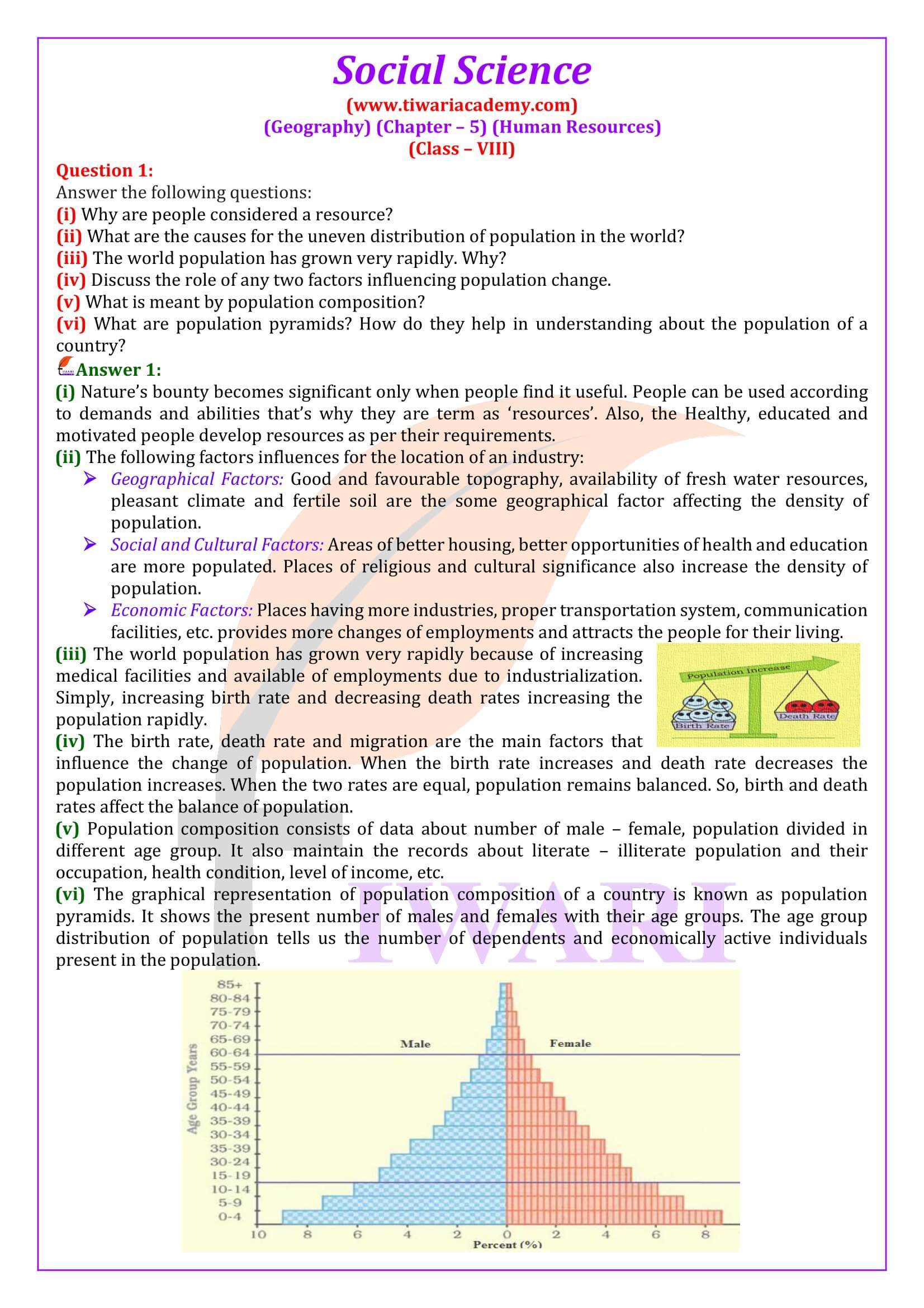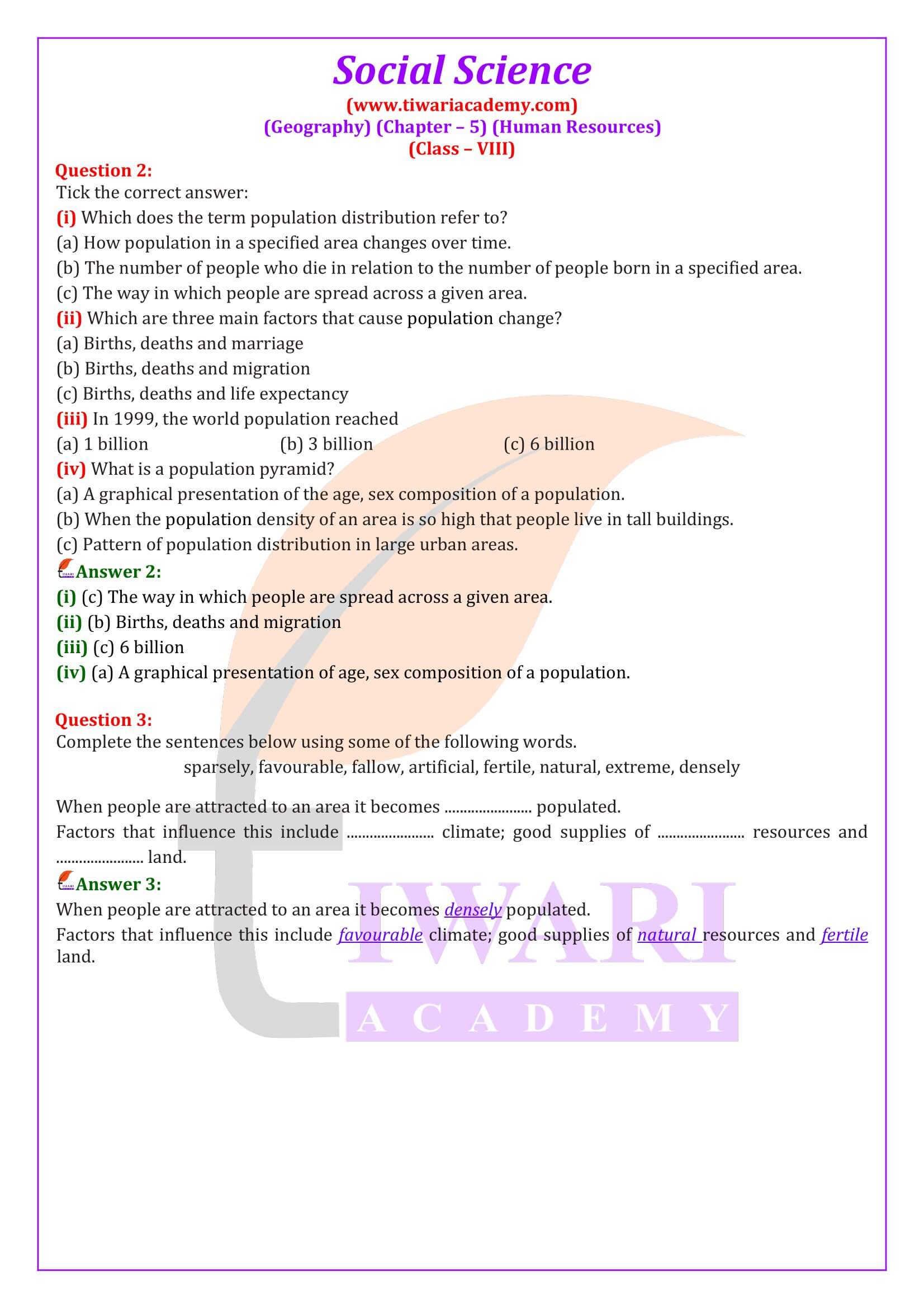NCERT Solutions for Class 8 Social Science Geography Chapter 5 Human Resources in Hindi and English Medium updated for new academic year 2024-25. Class 8 Geography Chapter 5 Solutions are modified and revised according to new textbooks issued by NCERT for session 2024-25.
NCERT Solutions for Class 8 Social Science Geography Chapter 5
| Class: 8 | Social Science |
| Subject: | Geography |
| Chapter 5: | Human Resources |
| Academic Session: | 2024-25 |
Class 8 Geography Chapter 5 extra Question
What do you mean by human as a resource?
Human resource: Human resource is the ultimate resource. Healthy, educated and motivated people develop resources as per their requirements. Human resources like other resources are not equally distributed over the world. They differ in their educational levels, age and sex. Their numbers and characteristics also keep changing. The way in which people are spread across the earth surface is known as the pattern of population distribution. More than 90 per cent of the world’s population lives in about 10 per cent of the land surface. The distribution of population in the world is extremely uneven.
What is Population Density?
Population density is the number of people living in a unit area of the earth’s surface. It is normally expressed as per square km. The average density of population in the whole world is 45 persons per square km. South Central Asia has the highest density of population followed by East and South East Asia.
Class 8 Geography Chapter 5 Question Answers
CBSE NCERT Solutions for Class 8 Social Science Geography Chapter 5 Human Resources is given below in updated form for session 2024-25. Download these solutions for offline use or use it online without downloading.
Important Questions on 8th Geography Chapter 5
Why are people considered a resource?
Nature’s bounty becomes significant only when people find it useful. People can be used according to demands and abilities that’s why they are term as ‘resources’. Also, the Healthy, educated and motivated people develop resources as per their requirements.
What are the causes for the uneven distribution of population in the world?
The following factors influences for the location of an industry: Geographical Factors: Good and favourable topography, availability of fresh water resources, pleasant climate and fertile soil are the some geographical factor affecting the density of population. Social and Cultural Factors: Areas of better housing, better opportunities of health and education are more populated. Places of religious and cultural significance also increase the density of population. Economic Factors: Places having more industries, proper transportation system, communication facilities, etc. provides more changes of employments and attracts the people for their living.
The world population has grown very rapidly. Why?
The world population has grown very rapidly because of increasing medical facilities and available of employments due to industrialization. Simply, increasing birth rate and decreasing death rates increasing the population rapidly.
Discuss the role of any two factors influencing population change.
The birth rate, death rate and migration are the main factors that influence the change of population. When the birth rate increases and death rate decreases the population increases. When the two rates are equal, population remains balanced. So, birth and death rates affect the balance of population.
What is meant by population composition?
Population composition consists of data about number of male – female, population divided in different age group. It also maintain the records about literate – illiterate population and their occupation, health condition, level of income, etc.
What are population pyramids? How do they help in understanding about the population of a country?
The graphical representation of population composition of a country is known as population pyramids. It shows the present number of males and females with their age groups. The age group distribution of population tells us the number of dependents and economically active individuals present in the population.
Tick the correct answer: In 1999, the world population reached (a) 1 billion (b) 3 billion (c) 6 billion.
(c) 6 billion
Important Notes on 8th Geography Chapter 5
THE FACTORS AFFECTING ON POPULATION DISTRIBUTION
Factors affecting on Population
1. Topography: People always prefer to live on plains rather than mountains and plateaus because these areas are suitable for farming, manufacturing and service activities. The Ganga plains are the most densely populated areas of the world while mountains like Andes, Alps and Himalayas are sparsely populated.
2. Climate: People usually avoid extreme climates that are very hot or very cold like Sahara desert, Polar Regions of Russia, Canada and Antarctica.
3. Minerals: Areas with mineral deposits are more populated. Diamond mines of South Africa and discovery of oil in the Middle East lead to settling of people in these areas.
4. Soil: Fertile soils provide suitable land for agriculture. Fertile plains such as Ganga and Brahmaputra in India, Hwang-He, Chang Jiang in China and the Nile in Egypt are densely populated.
5. Water: People prefer to live in the areas where fresh water is easily available. The river valleys of the world are densely populated while deserts have spare population.
More Factors of Population Distribution
1. Cultural: Places with religion or cultural significance attract people. Varanasi, Jerusalem and Vatican City are some examples.
2. Economic: Industrial areas provide employment opportunities. Large number of people are attracted to these areas. Osaka in Japan and Mumbai in India are two densely populated areas.
3. Social: Areas of better housing, education and health facilities are more densely populated e.g., Pune.






